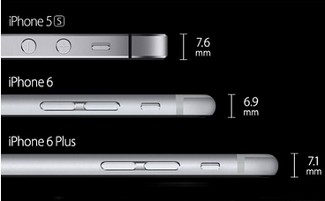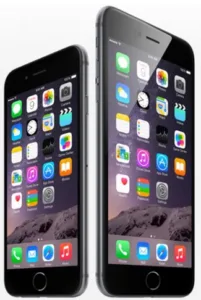Apple’s launch of the iPhone 6 came as no surprise. The company opted to stream the event as live video. There must have been millions of people clogging the internet, since all I got was some scrambled pictures between seconds of video without audio!
All the rumours about round edges on the new iPhone are entirely true. The rumour mill seems to have misjudged the readiness of Apple to use sapphire cover glass, however. Apple described the cover glass as, “an ion-strengthened thing of beauty” – that’s ion-strengthened glass (possibly Gorilla Glass), not sapphire. As we have argued before, the sapphire production capacity that GT Advanced Technologies built for Apple was not enough to support the use of sapphire in a mass-release device like the iPhone 6.
There will be two sizes: the iPhone 6, with a 4.7″ display, and the iPhone 6 Plus, with a 5.5″ display. Both phones are not only larger, but also have higher resolution screens. The iPhone 6 features 1334 x 750 and the iPhone 6 Plus has finally put Apple into the realms of 1920 x 1080. These translate into a pixel density of 326ppi and 401ppi, respectively. The displays are of the dual-domain IPS type, resulting in a wider viewing angle. The higher resolutions and larger screens mean that the iPhone 6 Plus has a higher pixel density than previous iPhone models, although the iPhone 6 retains the 326ppi of its predecessors.
There has been a significant increase in contrast ratios, from 800:1 in the iPhone 5 to 1,400:1 in the iPhone 6 and 1,300:1 in the iPhone 6 Plus. The displays are capable of showing the full sRGB color space, which is no different to the displays used in the iPhone 5. Apple stated that this is the best display on a smartphone in the market today; I am sure that many display specialists, including our friend Ray Soneira, will take an in-depth look to confirm or reject this statement.
The above means that Apple is still using LCD displays, as most rumours suggested. The introduction of AMOLED technology for the iPhone still lies in the future. It is anyone’s guess if this has been triggered by Apple believing that LCDs are the better display or the missing production capacity for AMOLED at this time.
A new landscape view has been added to the iPhone 6 Plus, taking full advantage of the larger display. This is again is a demonstration of why Apple excels in the development of new devices. Given a new form factor, display resolution or other technology-based specification, they take the next step by going after what the consumer can actually do with such functionality. The ‘reachability’ feature is also new; double-tapping (not pressing) the home button shifts the entire screen image down, hiding the bottom but putting the top in reach of a user’s thumb; a fairly innovative answer to the difficulty of navigating such large displays.
Apple’s new A8 chip increases processing power by 25% and graphical power by 50%. This means that the iPhone 6 is up to 50x faster, and the graphics up to 84% faster, than the original iPhone – making the iPhone 6 a very capable gaming machine as well.
There are a lot of other functions included that certainly will make the iPhone 6 as much of a success as earlier models. We will discuss those in a separate article.
The iPhone 6 launched on 19th September, starting at $200 on a contract. – Norbert Hildebrand
Display Daily Comments
We have heard that supply chain vendors are preparing to produce as many as 80 million iPhones before the end of the year. By comparison, ‘only’ 60 million iPhone 5s were shipped in 2013. (TA)


